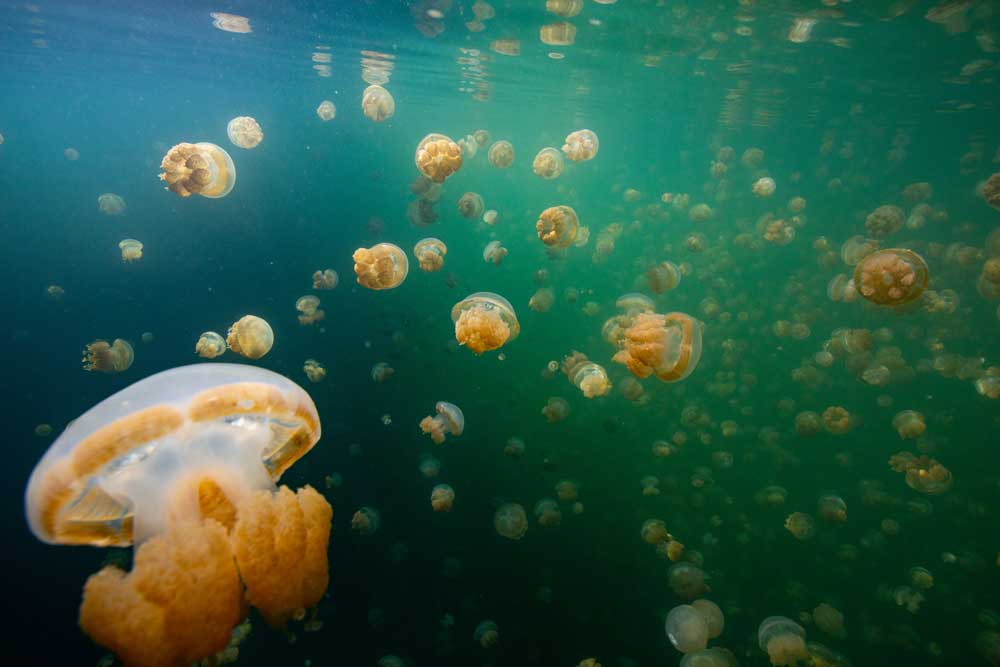
Your Complete Guide to Palau Liveaboard Diving in Micronesia
Dive into this comprehensive guide to learn everything about what makes Palau a top diving destination, from its unparalleled marine biodiversity to its stunning underwater landscapes.
Divers from around the globe are drawn to Palau primarily for its renowned diving spots, teeming marine life—particularly the abundant shark population—and vibrant coral reefs. The significant presence of sharks is a testament to the health of Palau's underwater ecosystems, which is largely due to the nation's progressive approach to marine conservation.
About Palau Liveaboard Diving
Dive in Palau to see lots of sharks, colorful fish, and amazing coral, all thanks to the country's strong focus on protecting marine life.
In a groundbreaking move in 2009, Palau established the world's inaugural shark sanctuary, providing protection for more than 135 shark species in the Western Pacific. Building upon this, the country went on to create the world's largest marine sanctuary in early 2014 by banning commercial fishing in an area as large as France.
Palau's dive sites are considered some of the most pristine and unspoiled in the Pacific. A month-long study conducted in 2015 by scientists from the Global Reef Expedition revealed that compared to other regional reefs, Palau's coral health is exceptional.
The researchers discovered that the average live coral cover in Palau exceeded 45%, with some marine protected areas (MPAs) showing coral density as high as 70%.
This level of coral cover is among the world's highest, even when measured against the planet's most celebrated coral ecosystems.
Palau Dive Sites
For the best diving experience on a Palau liveaboard, it is recommended having at least an advanced open water diver certification or equivalent, ideally with Nitrox as well. This allows you to dive deeper while also extending your bottom time, so you won't miss out on renowned dive sites like Blue Corner. Basic open water certification only permits dives up to 18 meters. However, Palau offers diving adventures for all skill levels. Even if you're not an advanced diver, you can still enjoy Palau's underwater wonders.
To put it in short, diving on a Palau liveaboard is can be presented just like this... Palau is an archipelago of over 500 islands, part of the Micronesia region in the western Pacific Ocean. For diving in Palau, most divers fly to Koror from Manila, Guam, Japan, Taipei and even Korea. Once you land, you can basically get on the boat and start diving
When To Go To Palau?
Palau is famous for good diving all year round and although you may visit in what is known as the rainy season, typically the rain falls in the majority at night with little effect on diving activities. Otherwise, Palau liveaboard diving benefits from three diving seasons.
High Season
If you have the possibility to choose, ideally you should go to Palau in the months between December and March. During these months, diving in Palau is usually at its best, with calm water, great visibility, and less rain. Make sure though to book your trips and activities in advance.
Shoulder Season
The months of April, July, August, October, and November are bringing quite some rain and the sea can be choppy but as always, Palau diving remains largely unaffected compared to other diving destinations around the world.
Low Season
May, June, and September are the most rainy months but on the upside, the dive sites are less crowded and most of them can still be accessible.
Tips For Travelers
Palau operates on Palau Time, abbreviated as PWT, which is 9 hours ahead of Greenwich Mean Time (GMT+9). The country doesn't adopt daylight savings, keeping it on UTC +9 throughout the year.
Palau’s currency is the US Dollar ($). Credit cards are widely accepted in tourist areas. Foreign currency exchange can be complicated, so remember to bring US dollars.
The official language spoken in Palau is Palauan. The second official language is English. Other common languages include Japanese and Tagalog.
In Palau, the electrical voltage is 110 Volts with a frequency of 60 Hz. If your devices aren't compatible with these specifications, you'll require a power adapter.
How to get there & Ports of Departure?
Reaching Palau may require some effort due to the limited number of direct flights available, but the journey is well worth it. When mapping out your trip to Palau, consider the following travel routes.
- From the U.S., flights typically connect through Guam.
- If you're coming from the Philippines, you'll likely fly through Manila.
- For travelers from Southeast Asia, Taipei or Seoul are common layover points.
- Koror, Palau
Primary Departure Point: Liveaboards in Palau usually depart from Malakal Harbour in Koror, the largest city in Palau.
Nearest Airport: The Roman Tmetuchl International Airport serves Koror and is located on the island of Babeldaob, connected to Koror by a bridge.
Getting to Koror: Direct flights to Palau are limited to only five destinations—Philippines, Taiwan, South Korea, Japan, and Guam. You'll likely have to fly into one of these hubs first before making your way to Palau.
Essential Travel Tips for Liveaboard Adventures
- Marine Park Fees: Be aware of per person, per day marine park fees. Some liveaboard packages include these fees, while others require onboard payment. Payment options include Visa, Mastercard, cash, or travelers checks.
- Passport Validity: Ensure your passport is valid for at least 6 months after your planned entry date. Most countries require this, along with a return ticket. Check visa requirements in advance.
- Health Preparations: Consult your doctor 8 weeks prior to your trip for vaccinations or preventive measures recommended for your destination.
Note: Please review the specific terms and conditions of your chosen liveaboard for any additional marine park fees or travel requirements.
We're Here to Help 24/7






